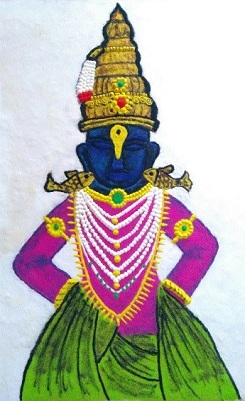Ashadhi Ekadashi: 800-year-old tradition of Bhagwat Dharma
| Date :01-Jul-2020 |

Swati Abhinandan Mahatme has drawn this rangoli at Patrakar Sahaniwas, Maharajbag Road, to mark Ashadhi Ekadashi on Wednesday.
By Rajendra Diwe :
“DNYANDEVE Rachila Paaya, Tuka Zalase Kalasa”. The famous abhanga in Marathi tells the importance of Bhagwat Dharma whose foundation was laid by Saint Dnyaneshwar and later Saint Tukaram assumed the apex of it. For the followers of Bhagwat Dharma, the eleventh lunar day of Shukla Paksha (bright Moonlight) in Ashadh month of Hindu calendar and the eleventh lunar day of Shukla Paksha of Kartik month are very important. The eleventh lunar day in Ashadh is known as Ashadhi Ekadashi. It is also known as Devshayani Ekadashi.
The followers of Bhagwat Dharma conduct ‘Wari’, an annual pilgrimage of Pandharpur each year on Ashadhi Ekadashi. People across Maharashtra will celebrate Ashadhi Ekadashi on July 1 but for the first time there will be no pilgrimage of Pandharpur due to coronavirus pandemic. Ashadhi Ekadashi is also considered as a day of start of Chaturmas.
As it is known as Devshayani Ekadashi, the devotees believe God Vishnu goes to sleep in Kshirsagar for four months. These four months are termed as Chaturmaas and it will conclude on Kartiki Ekadashi which is also known as Prabodhini Ekadashi means a day of ending sleep of God Vishnu. The tradition of organising Wari on every Ashadhi Ekadashi is more than 800 years old in Maharashtra. Saint Dnyaneshwar established Bhagwat Dharma in the society through His ‘Dnyaneshwari’ and started the tradition of ‘Namdindi’, that is, Wari of Pandhari with a view to spread and propagate Bhagwat Dharma. Collective chanting of Vitthal’s Name by all warkaris appears like ‘Naamdindi’. Those who participate in this Pandharpur Wari automatically sacrifice their body, mind and money at the feet of God.
One has purity of mind while travelling to meet God eagerly and the physical body too wears away like sandalwood. Therefore, warkaris heading towards Pandharpur are on a pilgrimage called wari. As per the Hindu calendar, there are 24 Ekadashis in the span of one year. The Ekadashi in Shukla Paksha of Ashadh is termed as Devshayani Ekadashi while the one in Krishna Paksha is called Kamika Ekadashi. As per the legend, “In ancient times, war took place between Gods and demons. Mrudumanya, son of demon Kumbha had the boon of immortality from Deity Shiva through penance. As a result, he became unconquerable for Brahma, Vishnu and Shiva. Fearing him, the Gods hid on the Trikut mountain, in a cave underneath an Amla tree. As they had no food, it resulted in their fasting on the day of Ashadhi Ekadashi. They bathed in the rain. Then all of a sudden, energy was created from their breath which killed the demon Mrudumanya who was waiting at the entrance of the cave. This energy is the Goddess of Ekadashi.”
“The devotee observing Ekadashi vrat has to eat only once on the previous day, i.e. on Dashami. He must bathe early morning on Ekadashi and worship Shri Vishnu by offering tulsi leaves. He has to fast the whole day and has to engage himself in kirtan (devotional songs/discourses) and remain awake the whole night. The next day, on Ashadh Shukla Dwadashi, he has to worship Deity Vaman and eat something to break the fast. On both these days Shri Vishnu is worshipped by the name ‘Sridhar’ and a ghee lamp is kept burning through the night,” a legend says. n Ekadashi Tithi begins - 07:49 PM on June 30, 2020 n Ekadashi Tithi Ends - 05:29 PM on July 01, 2020